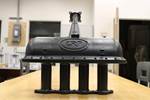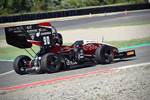Composite accelerator pedal enhances Formula SAE performance
Venox Systems was brought into the fold to deliver a 3D printed continuous carbon fiber/PEKK pedal for the TU Wien Racing Team that exceeded its aluminum counterpart.
The final composite accelerator pedal versus the aluminum version. Source (All Images) | Venox Systems
In close partnership with the TU Wien Formula SAE Racing Team, Venox Systems (Lingenau, Austria) was tasked with developing a composite gas pedal made of continuous carbon fiber with optimized performance and durability for improved driving results, as well as reduced cost and shortened production time. Final results, which met these objectives, in addition to successfully outperforming aluminum versions in terms of lightness and strength, were used for the 2023’s Formula SAE racing series.
Formula SAE is a worldwide competition for technical engineering in which student teams from countries across the world compete against each other with their own designed and developed race cars. Prior to reaching out to Venox, the TU Wien team was using a gas pedal made out of aluminum. While easy to obtain, easy to work with, thanks to its good formability, and its protection against corrosion via an oxide layer, its weight and specific tensile strength compared to something like carbon fiber made it disadvantageous, especially in a race where every gram counts.
Venox Systems’ go-to solution was 3D printed continuous carbon fiber. It maintains a specific density of 1.9 newtons/square millimeter (179 N/mm2)(versus aluminum’s 2.8) and its strength reaches 1,600 grams/per cubic centimeter (versus 500), representing a 320% improvement. However, the difference between the two materials became particularly clear when the strength-to-density ratio was compared, according to Venox. The carbon fiber-reinforced polyetherketoneketone (PEKK) achieved a specific strength of 842 179 N/mm2, compared to aluminum’s 179 N/mm2 — an improvement of 472%.
When considering motorsports, these distinctions are important. Any weight reduction enables a more precise weight distribution, which leads to an increase in balance, traction and agility. A high specific tensile strength
means that the material is more resistant and can withstand more load.
Production time is another critical factor. The aluminum component requires around 4 weeks due to preparation time, while the 3D printed carbon fiber/PEEK component can be produced in around 2 weeks; printing time takes only about 12 hours. Moreover, additive manufacturing often enables production of components with improved mechanical properties, optimized material efficiency and increased design flexibility compared to the subtractive production of aluminum.
Related Content
-
Combining multifunctional thermoplastic composites, additive manufacturing for next-gen airframe structures
The DOMMINIO project combines AFP with 3D printed gyroid cores, embedded SHM sensors and smart materials for induction-driven disassembly of parts at end of life.
-
Welding is not bonding
Discussion of the issues in our understanding of thermoplastic composite welded structures and certification of the latest materials and welding technologies for future airframes.
-
JEC World 2024 highlights: Thermoplastic composites, CMC and novel processes
CW senior technical editor Ginger Gardiner discusses some of the developments and demonstrators shown at the industry’s largest composites exhibition and conference.

















